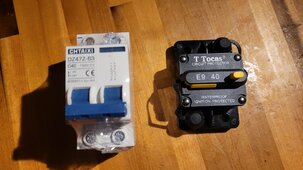downhilltrucker
New Member
I am setting up a big solar setup in a van I'm building. I noticed most folks seem to use a cutoff/fuse in between the panels and the MPPT like the left fuse. In my previous solar setups, I have used fuses like the one on the right. Should I be using something like the left setup?

For background, I have 400w (2 200w panels in series going to a Victron 100/30 MPPT. Here are the specs for each 200w panel:

For background, I have 400w (2 200w panels in series going to a Victron 100/30 MPPT. Here are the specs for each 200w panel:
- Max Operating Voltage (Vmpp): 18.90Volts Max Operating Current (Imp): 10.58Amps Open Circuit Voltage (Voc): 21.86Volts Short Circuit Current (Isc): 10.99 Amps



